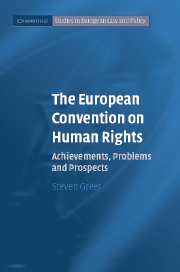3 - The Applications and Enforcement of Judgment Processes
Published online by Cambridge University Press: 13 July 2009
Summary
INTRODUCTION
As already indicated in Chapter 1, given the effective demise of inter-state complaints, individual applications have become the life-blood of the Convention system. A separate process enables the Committee of Ministers of the Council of Europe to consider whether or not judgments in an applicant's favour are properly observed by the state concerned. The purpose of this chapter is to consider how both these processes operate, paying particular attention to the modifications contained in Protocol 14, which are likely to come into operation in late 2006 or early 2007. As already indicated, according to the President of the Court, Professor Luzius Wildhaber, although it constitutes ‘a step in the right direction … (e)ven with the new reform, the Court will continue to have an excessive workload’. Assuming, as this study does, that this verdict is correct, two key questions now need to be addressed. The first, the subject of this chapter, is: what further changes are required within the existing institutional structure in order, simultaneously, to enable the Court's burgeoning case load to be dealt with more effectively, and for the Court to contribute more strategically to raising the level of Convention compliance throughout Europe? In seeking answers, relevant documentary sources have been supplemented by interviews with judges and officials in Strasbourg and with representatives of Amnesty International in London (hereafter the ‘Strasbourg’ and ‘London’ interviews respectively). The second question, which will be considered in Chapter 6, is what institutional innovations might also be required.
- Type
- Chapter
- Information
- The European Convention on Human RightsAchievements, Problems and Prospects, pp. 136 - 192Publisher: Cambridge University PressPrint publication year: 2006
- 1
- Cited by



